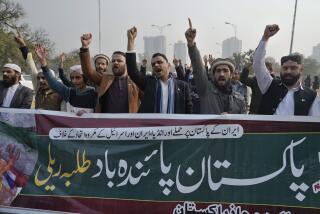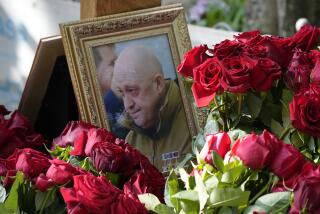Theories Vary on C-130 Crash; One Is the ‘Mango Bomb’ : Zia’s Death Brings Plenty of Speculation
- Share via
ISLAMABAD, Pakistan — Since President Zia ul-Haq died last week in a mysterious air crash, the stories making the rounds of official and diplomatic circles in Pakistan have all the makings of a Hollywood movie plot--several plots, in fact.
There is the “mango bomb” theory.
There is the one about the fanatic Shia Muslim crew member who carried an explosive on board the plane.
There are several variations on a scenario involving a surface-to-air missile, ranging from Afghan secret police firing the missile via remote control to the Soviet Union bringing down Zia’s plane from a high-flying satellite with an intricate detonation system aboard.
And there are still a few observers who refuse to rule out simple mechanical failure or pilot error.
City of Intrigue
Most of the speculation is based on rumor and the fact that, even in the best of times, Islamabad is a city that relishes intrigue.
Indeed, in the days since the Aug. 17 air disaster in Bahawalpur, Pakistan, the speculation has persisted and fed on itself among officials and members of the public alike. But the new Pakistani government is acutely aware of the implications, both domestic and international, of pointing a finger in any direction.
After a week of closely guarded investigation, about all that is clear is that military and civil authorities are convinced that the crash of Zia’s C-130 presidential transport plane, which also killed U.S. Ambassador Arnold L. Raphel, a senior U.S. defense attache and 10 top Pakistani generals, was no accident.
“If you put all these theories together, you’d have one hell of a novel, but the one thing you don’t have yet is the truth,” observed one Western analyst, who asked not to be identified by name.
“What is important to keep in mind is that this whole thing is so sensitive, so potentially explosive, that the Pakistanis may never let the world--even their own countrymen--know what really happened on board that C-130. If it is the Soviets, what could a small country like Pakistan do?”
If the government does learn that the Soviets are responsible, or the Afghans or the Indians, disclosing this information would take the country close to war--and Pakistan can ill afford a war just now.
The results of the investigation, being carried out by a joint team of U.S. and Pakistani experts, are not likely to be announced for another week or two.
Pakistani military intelligence has advised Zia’s successor, Ghulam Ishaq Khan, and his Cabinet of the investigation’s preliminary findings, but ministers who attended the session said they were given only the “sketchiest details.” The head of the U.S. team briefed the president Tuesday.
Evidence for Islamabad
The explosion and fire destroyed much of the aircraft, but according to sources who have visited the crash site, much of the wreckage has been recovered, sealed and sent to Islamabad for analysis.
Police investigators, aided by the FBI, have taken statements from witnesses in the area and from local officials and residents who presented Zia and the ambassador with gifts, among them several crates of mangoes. One theory suggests that a bomb may have been placed in one of those crates.
Police also interviewed members of the ground staff at the Bahawalpur airport, where the plane had been parked under military guard.
One obstacle for the investigators is the witnesses’ widely varying versions of what happened. Several said they saw the plane, trailing smoke, somersault out of control and bounce twice on the ground before exploding, but others reportedly have said they saw the plane explode and then fall to the ground in many pieces.
Plane Briefly Airborne
According to air traffic controllers, the plane was airborne for less than five minutes before the crash and did not reach an altitude of more than 2,000 feet.
Like retired Air Marshal Zulfikar Ali Khan, several former officers have interpreted the reports as meaning that a bomb was the most likely cause of the crash.
Ali Khan said he ruled out a missile because most surface-to-air missiles now in use are of the heat-seeking type. These would hit an engine, he said--and the C-130 is capable of flight with only two of its four engines operating, so more than one missile would have been required to bring it down.
He also ruled out mechanical failure, noting that since C-130s went into service here in 1962, only three have crashed, all because of bad weather.
Despite the widely held opinion that sabotage was to blame, no one among the Pakistani leadership has hinted at where the responsibility might lie.
Pakistan has potentially hostile neighbors--India, Afghanistan and the Soviet Union. It has fought three wars with India, and Prime Minister Rajiv Gandhi of India has recently warned Pakistan to stop supporting Sikh separatists in the Indian border state of Punjab or “face the consequences.”
Also, Zia was the most active benefactor of the moujahedeen , the Afghan rebels who have been fighting the Afghan government.
Privately, Pakistani intelligence officials and Western diplomats have been pushing the theory that the Afghan secret police is responsible for the Zia crash, perhaps with Soviet assistance.
“If you look at who had the most to gain by Zia’s death, it has to be (Afghan President) Najibullah and the Soviets,” a Western diplomat said, asking not to be named.
Yet Moscow has dismissed all such speculation as unfounded.
Theories advanced by Asian diplomats and opposition Pakistani politicians tend to focus on domestic issues, specifically the conflict between majority Sunni and minority Shia Muslims, and potential divisions within the armed forces.
Shias Celebrating
Three weeks before Zia was killed, the leader of the principal Shia political party was assassinated at a mosque near Peshawar, and many Shias blamed the Zia government. Since Zia’s death, militant Shias have celebrated openly.
Several Eastern diplomats said it was possible that one of the 13 members of the crew on Zia’s plane had sought Shia martyrdom by carrying a bomb on board.
These notions also suggest divisions within the military, an institution so secretive and hidden from view that a local newspaper editor, Maleeha Lodhi, has compared it to the Masonic order.
“You hear it hum,” he said, “but you don’t know what’s going on inside.”
More to Read
Sign up for Essential California
The most important California stories and recommendations in your inbox every morning.
You may occasionally receive promotional content from the Los Angeles Times.













